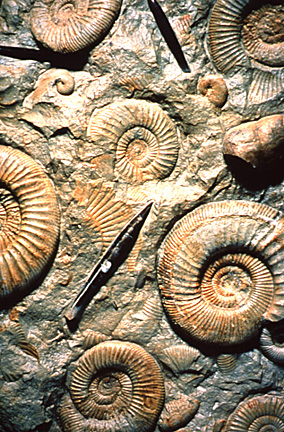
| Belemnites are an extinct group of marine cephalopods.
They are very similar in many ways to the modern squid. and closely related
to the modern cuttlefish. Like them, they belemnites possessed an
ink sac, and ten arms tentacles.
They were numerous during the Jurassic and Cretaceous periods, and their fossils occur abundantly in Mesozoic marine rocks, becoming extinct at the end of the Cretaceous period along with their cousins the ammonites. Other cephalopods include goniatites and nautiloids. To learn more about ammonites, goniatites, and nautiloids, just click on the appropriate icons below |
||
Ammonites |
Goniatites |
Nautiloids |
| With fossil belemnites, only the back part of the shell, called the guard or rostrum, is normally found. The guard, elongated and bullet-shaped, is cylindrical and either pointed or rounded at one end. The hollow region at the front of the guard is called the alveolus, and this houses a chambered conical shaped part of the shell called the phragmocone. Projecting forward from one side of the phragmocone is the thin pro-ostracum. |  |
|
| The guard, phragmocone and pro-ostracum were all internal to the living creature, forming a skeleton which was enclosed entirely by soft muscular tissue. The guard would have been in place towards the rear of the creature, with the phragmocone behind the head, and the pointed end of the guard facing backwards. Belemnite guards are composed of calcite and they have a tendency to preserve well. In broken specimens, a structure of radiating calcite fibers can be seen, and it may also display some concentric growth rings. The guard of the belemnite Megateuthis, which is found in Europe and Asia, measures 50 to 60 centimeters in length (20 to 24 inches). This gives it an estimated length of 3 meters (over 11 feet). | ||
 |
||
| The original living creature would have been larger than the fossilized shell, with a long streamlined body, prominent eyes, and arms which carried a series of small hooks for grabbing prey. Many phosphatic hooks from the arms of cephalopods are frequently contained in the fossilized stomachs of Ichthyosaurs, giving the impression that belemnites would have been a large part of the diet for such marine reptiles | ||
| Some belemnites serve as zone, or index fossils, particularly in the Cretaceous Chalk formation of Europe. This enables geologists to date the age of the rocks in which they are found. To learn more about geology, just click on the icon below. | ||
|
|
||
 Return
to The History House home page.
Return
to The History House home page.|
|
 |
 |